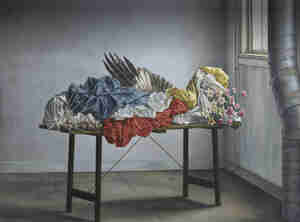- Plan your visit
- See and do
- Collection
- About us

Go back
Wim Schuhmacher
Dead Seagull on the Beach, 1936
Wim Schuhmacher (1894-1986) is often mentioned in the same breath as his contemporaries Carel Willink (1900-1983), Pyke Koch (1901-1991), Raoul Hynckes (1893-1973) and Dick Ket (1902-1940). Together, they are also regarded as the ‘Big Five’ of Neorealism, which spread from France, Italy, and Germany
...
throughout the world in the 1920s. Yet these artists undeniably each had their own artistic voice. So too did Schuhmacher, who sought out timeless subjects, an almost religious spiritualization of visible matter.
Although highly precise, Schuhmacher’s technique is not mirror-smooth. He applied the layers of paint opaquely to the canvas, in contrast to traditional academic painting techniques of working with wafer-thin layers of paint. Schuhmacher’s ‘coarse’ method has more in common with Impressionism and Expressionism.
However, the parallels between the nature of Schuhmacher’s work and that of his Impressionist predecessors are few. The silver light in Dead Seagull on the Beach is by no means a rendering of a brief moment in time , but rather its opposite. The alienating effect of the metal-grey veil over the ‘earthly’ representation and the attention to detail are unmistakably part of the Neorealism in the period between the two World Wars. The tranquil atmosphere in this ‘outdoor still life’ has sometimes been called ‘Gothic without God.’
Text: Myrthe Wesseling, guide and museum host
Artist
Wim Schuhmacher
Title
Dead Seagull on the Beach
Year
1936
Technique
Oil on canvas
Size
78 x 114 cm (h x w)
Type of object
Painting
Copyright
© Wilma Schuhmacher
This work is protected by copyright. You need permission from the creator or his heir to download, edit, copy or publish it.










